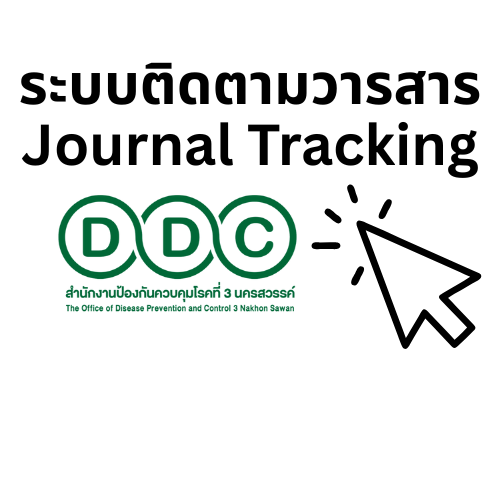สถานการณ์และแนวโน้มของเชื้อมัยโคแบคทีเรียก่อโรคที่ตรวจพบจากตัวอย่างเพาะเชื้อจากเลือด ในเขตพื้นที่ภาคกลางตอนบนของประเทศไทย
คำสำคัญ:
เชื้อมัยโคแบคทีเรีย, การเพาะเชื้อจากเลือดบทคัดย่อ
เชื้อวัณโรค Mycobacterium tuberculosis complex (MTBC) และเชื้อ non-tuberculous mycobacteria (NTM) บางชนิด เป็นเชื้อมัยโคแบคทีเรียก่อโรคในคน และเป็นเชื้อสำคัญที่ก่อโรคแบบฉวยโอกาสในผู้ติดเชื้อเอชไอวี หากเกิดการติดเชื้อมัยโคแบคทีเรียในกระแสเลือดจะทำให้ผู้ป่วยเสี่ยงต่อการเสียชีวิต การวิจัยนี้จึงได้ทำการศึกษาข้อมูลย้อนหลังของการตรวจตัวอย่างเพาะเชื้อมัยโคแบคทีเรียจากเลือด ที่โรงพยาบาลส่งตรวจ ณ ห้องปฏิบัติการวัณโรค สำนักงานป้องกันควบคุมโรค 3 จังหวัดนครสวรรค์ โดยมีวัตถุประสงค์เพื่อวิเคราะห์สถานการณ์และแนวโน้มของเชื้อมัยโคแบคทีเรียที่ก่อให้เกิดการติดเชื้อในกระแสเลือด ในช่วงปีงบประมาณ 2553-2559 มีตัวอย่างเพาะเชื้อมัยโคแบคทีเรียจากเลือด จำนวน 90 ตัวอย่าง เป็นตัวอย่างเพศชายมากกว่าเพศหญิงในอัตราส่วน 2.1:1 ผู้ป่วยส่วนใหญ่ร้อยละ 97.8 มีอายุอยู่ในช่วง 20-60 ปี โดยมีค่ามัธยฐานของอายุผู้ป่วยเท่ากับ 38 ปี เป็นผู้ป่วยที่ทราบประวัติการติดเชื้อเอชไอวีร้อยละ 55.6 เชื้อมัยโคแบคทีเรียที่พบเป็นเชื้อ NTM (ร้อย 51.1) มากกว่าเชื้อวัณโรค (ร้อยละ 48.9) เชื้อวัณโรคที่พบส่วนใหญ่เป็นเชื้อที่ไวต่อยาวัณโรคแนวที่ 1 คิดเป็นร้อยละ 77.3 พบเชื้อวัณโรคดื้อยาหลายขนาน multidrug-resistant TB (MDR-TB) ร้อยละ 4.5 โดยในตัวอย่าง MDR-TB นี้พบว่ามี 1 ตัวอย่างดื้อต่อยาวัณโรคแนวที่ 2 ร่วมด้วย ได้แก่ ofloxacin และ cycloserine ในจำนวนเชื้อ NTM ทั้งหมด เชื้อที่พบมากที่สุดคือเชื้อ M. avium (ร้อยละ 56) สำหรับเชื้อ NTM ชนิดอื่นที่พบ ได้แก่ M. intracellulare (ร้อยละ 7) M. abscessus (ร้อยละ 2) M. kansasii (ร้อยละ 2) และพบเชื้อ NTM ที่ไม่สามารถแยกชนิดได้ด้วยวิธี line-probe assay (LPA) สูงถึงร้อยละ 13 แนวโน้มการก่อโรคของเชื้อมัยโคแบคทีเรียพบว่าเชื้อวัณโรคมีสัดส่วนการก่อโรคลดลงจากร้อยละ 60.0 ในปี 2553 เหลือเพียงร้อยละ 41.2 ในปี 2559 ขณะที่พบสัดส่วนการก่อโรคของเชื้อกลุ่ม NTM เพิ่มสูงขึ้นจากร้อยละ 40.0 ในปี 2553 เป็นร้อยละ 58.8 ในปี 2559 จากการศึกษานี้จะเห็นได้ว่าการติดเชื้อมัยโคแบคทีเรียในกระแสเลือดมีความเกี่ยวข้องกับการติดเชื้อเอชไอวี ดังนั้นการควบคุมโรคจึงจำเป็นต้องดำเนินการควบคู่กันไปกับการควบคุมเอชไอวี ซึ่งมีกลุ่มเป้าหมายหลักเป็นวัยทำงาน และสิ่งสำคัญอีกหนึ่งประการคือ การเพิ่มขึ้นอย่างต่อเนื่องของเชื้อ NTM ในตัวอย่างเพาะเชื้อจากเลือด ซึ่งอาจจะก่อให้เกิดปัญหาสาธารณสุขในอนาคต ดังนั้นจึงควรให้ความสำคัญ และมีการเฝ้าระวังเชื้อ NTM มากยิ่งขึ้น
เอกสารอ้างอิง
2. World Health Organization. Global tuberculosis report 2016. Geneva, Switzerland: WHO; 2016.
3. Halstrom S. Price P, Thomson R. Review: environmental mycobacteria as a cause of human infection. Int J Mycobacteriol 2015; 4: 81-91.
4. American Thoracsic Society. Diagnostic standards and classification of tuberculosis in adults and children. Am J Respir Crit Care Med 2000; 161: 1376-95.
5. The Joint United Nations Programme on HIV and AIDS. HIV-related opportunistic diseases. Geneva, Switzerland: UNAIDS; 1998.
6. Naba MR, Kanafani ZA, Awar GN, Kanj SS. Profile of opportunistic infections in HIV-infected patients at a tertiary care center in Lebanon. J Infect Public Health 2010; 3: 130-3.
7. Takalkar AA, Saiprasad GS, Prasad VG, Madhekar NS. Study of opportunistic infections in HIV seropositive patients admitted to Community Care Centre (CCC), KIMS Narketpally. Biomed Res 2012; 23: 139-42.
8. Mitiku H, Weldegebreal F, Teklemariam Z. Magnitude of opportunistic infections and associated factors in HIV-infected adults on antiretroviral therapy in eastern Ethiopia. Dove Med Press 2015; 7: 137–44.
9. Sandhu A. Samra AK. Opportunistic infections and disease implications in HIV/AIDS. Int J Pharm Sci Invent 2013; 2: 47-54.
10. Department of Health and Human Services. Guidelines for prevention and treatment of opportunistic infections in HIV-Infected adults and adolescents [Internet]. USA. [cited 2017 Apr 16]. Available from: https://aidsinfo.nih.gov/contentfiles/lvguidelines/AdultOI TablesOnly.pdf
11. Chetchotisakd P, Kiertiburanakul S, Mootsikapun P, Assanasen S, Chaiwarith R, Anunnatsiri S. Disseminated nontuberculous mycobacterial infection in patients who are not infected with HIV in Thailand. Clin Infect Dis 2007; 45: 421-7.
12. Archibald LK, Dulk MOD, Pallangyo KJ, Reller LB, Fatal Mycobacterium tuberculosis bloodstream infections in febrile hospitalized adults in Dar es Salaam, Tanzania. Clin Infect Dis 1997; 26: 290-6.
13. Clump JA, Ramadhani HO, Morrissey AB, Saganda W, Mwako MS, Yang LY, et al. Bacteremic disseminated tuberculosis in Sub-Sahalan Africa: a prospective cohort study. Clin Infect Dis 2012; 55: 242-50.
14. Jacob ST, Pavlinac PB, Nakiyingi L, Banura P, Baeten JM, Morgan K, et al. Mycobacterium tuberculosis bacteremia in a cohort of HIV-infected patients hospitalized with severe sepsis in Uganda-high frequency, low clinical sand derivation of a clinical prediction score. PloS One 2013; 8(8): e70305. DOI: 10.1371/journal.pone.0070305. PubMed Central PMCID: PMC3734073.
15. Kobayashi T, Nishijima T, Teruya K, Aoki T, Kikuchi Y, Oka S, Gatanaga H. High mortality of disseminated non-tuberculous mycobacterial infection in HIV infected patients in the vntiretroviral therapy era. PLoS One 2016; 11(3): e0151682. DOI: 10.1371/journal.pone. 0151682.
16. Office of the National Economics and Social Development Board. Social and quality of life database system [Internet]. Thailand. [cited 2017 May 7]. Available from: http://social.nesdb.go.th/SocialStat/StatReport_Final.aspx?reportid=1114&template=1R2C&yeartype=M&subcatid=17
17. Keshavjee S, Farmer PE. Tuberculosis, drug resistance and the history of modern medicine. N Engl J Med 2012; 367: 931-6.
18. American Thoracsic Society. An official ATS/IDSA statement: diagnosis, treatment, and prevention of nontuberculous mycobacterial diseases. Am J Respir Crit Care Med 2007; 175: 367-416.
19. Chuchottaworn C, Sathapatayawongs B, Tansuphsawadikul S, Suwanagool S, Kantipong P, Pornchaipoonthavee S. Prevalence of disseminated Mycobacterium avium complex infection in Thai AIDS patients. J Med Assoc Thai 1999; 82: 643-7.
20. Faria S, Joao I, Jordao L. General overview on nontuberculous mycobacteria, biofilms, and human infection. J Pathog 2015. Article ID 809014. 10 pages. http://dx.doi.org/10. 1155/2015/809014
21. กรมควบคุมโรค กระทรวงสาธารณสุข. ผลการดาเนินงานควบคุมวัณโรคปีงบประมาณ 2552 – 2558. [อินเทอร์เน็ต]. [สืบค้นเมื่อ 12 พ.ค. 2560]. แหล่งข้อมูล: https://www.tbthailand.org/documents. html
22. Johnson MM, Odell JA. Nontuberculous mycobacterial pulmonary infections. J Thorac Dis 2014; 6(3): 210-20. DOI: 10.3978/j.issn.2072-1439.2013.12.24
ดาวน์โหลด
เผยแพร่แล้ว
รูปแบบการอ้างอิง
ฉบับ
ประเภทบทความ
สัญญาอนุญาต
ประกาศเกี่ยวกับลิขสิทธิ์
|
บทความที่เผยแพร่ในวารสารโรคและภัยสุขภาพสำนักงานป้องกันควบคุมโรคที่ 3 จังหวัดนครสวรรค์ ถือว่าเป็นผลงานทางวิชาการหรือการวิจัย และวิเคราะห์ ตลอดจนเป็นความเห็นส่วนตัวของผู้เขียน ไม่ใช่ความเห็นของสำนักงานป้องกันควบคุมโรคที่ 3 จังหวัดนครสวรรค์ หรือกองบรรณาธิการแต่ประการใด ผู้เขียนต้องรับผิดชอบต่อบทความของตน |
นโยบายความเป็นส่วนตัว
|
ชื่อและที่อยู่ อีเมล์ ที่ระบุในวารสารโรคและภัยสุขภาพสำนักงานป้องกันควบคุมโรคที่ 3 จังหวัดนครสวรรค์ จะใช้เพื่อระบุตามวัตถุประสงค์ของวารสารเท่านั้น และจะไม่นำไปใช้สำหรับวัตถุประสงค์อื่น หรือต่อบุคคลอื่น |








